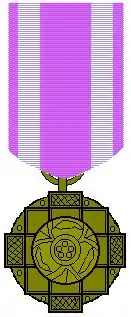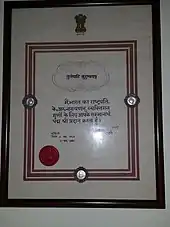Padma Shri
Padma Shri (IAST: padma śrī), also spelled Padma Shree, is the fourth-highest civilian award of the Republic of India, after the Bharat Ratna, the Padma Vibhushan and the Padma Bhushan. Instituted on 2 January 1954, the award is conferred in recognition of "distinguished contribution in various spheres of activity including the arts, education, industry, literature, science, acting, medicine, social service and public affairs". It is awarded by the Government of India every year on India's Republic Day.[1]
| Padma Shri | |
|---|---|
 | |
| Type | National Civilian |
| Country | |
| Presented by | Government of India |
| Ribbon | |
| Obverse | A centrally located lotus flower is embossed and the text "Padma" written in Devanagari script is placed above and the text "Shri" is placed below the lotus. |
| Reverse | A platinum State Emblem of India placed in the centre with the national motto of India, "Satyameva Jayate" (Truth alone triumphs) in Devanagari Script |
| Established | 1954 (1954) |
| First awarded | 1954 |
| Last awarded | 2023 |
| Total | 3225 |
| Website | www |
| Precedence | |
| Next (higher) | |
| Next (lower) | |
History

Padma Awards were instituted in 1954 to be awarded to citizens of India in recognition of their distinguished contribution in various spheres of activity including the arts, education, industry, literature, science, acting, medicine, social service and public affairs. It has also been awarded to some distinguished individuals who were not citizens of India but did contribute in various ways to India.
The selection criteria have been criticised in some quarters with the claim that many highly deserving artists have been left out in order to favour certain individuals.[2][3] India has now created an online nomination platform for the common citizens to recommend the nomination for the annually given civilian "Padma" awards.[4]
On its obverse, the words "Padma", meaning lotus in Sanskrit, and "Shri", a Sanskrit-derived honorific equivalent to 'Mr.' or 'Ms.' (i.e., "Noble One in Blossom"), appear in Devanagari above and below a lotus flower. The geometrical pattern on either side is in burnished bronze. All embossing is in white gold.
As of 2023, 3421 people have received the award. In 2023, 91 people received the Padma Shri.
Refusals
Several intended recipients, including musician Hemanta Kumar Mukherjee, sitar player Vilayat Khan,[5] academic and author Mamoni Raisom Goswami,[6] journalist Kanak Sen Deka[7] and noted Bollywood screenwriter Salim Khan, have declined the Padma Shri for various reasons.[8] Some intended recipients, such as environmental activist Sunderlal Bahuguna[9] and English billiards champion Michael Ferreira,[7] have refused the honour but have subsequently accepted a more prestigious one such as the Padma Bhushan or Padma Vibhushan. Other individuals, such as film-maker Aribam Syam Sharma,[10] author Phanishwar Nath 'Renu',[11] Punjabi author Dalip Kaur Tiwana[12] and noted poet Jayanta Mahapatra,[13] have returned the honour after initially accepting it.
In 2022, renowned Bengali singer "Gitashri" Sandhya Mukhopadhyay, aged 90, turned down her offer for the Padma Shri award on the eve of the 73rd Republic Day of India. As per media reports, the veteran singer turned down the offer since she believes that her career spanning eight decades deserved a higher award than the Padma Shri. "Padma Shri is more deserving for a junior artiste", her daughter said.[14] Based on her refusal, her name was not included in the Padma awardees list for 2022.
Awards by decade
- List of Padma Shri award recipients (1954–1959)
- List of Padma Shri award recipients (1960–1969)
- List of Padma Shri award recipients (1970–1979)
- List of Padma Shri award recipients (1980–1989)
- List of Padma Shri award recipients (1990–1999)
- List of Padma Shri award recipients (2000–2009)
- List of Padma Shri award recipients (2010–2019)
- List of Padma Shri award recipients (2020–2029)
Awards by field/occupation
Recipients of Padma Shri in the "Others" Category | |
|---|---|
| 1950s |
|
| 1960s |
|
| 1970s |
|
| 1980s |
|
| 1990s |
|
| 2000s |
|
| 2010s |
|
| 2020s |
|
References
- "Padma award's schema" (PDF). Ministry of Home Affairs. Retrieved 13 August 2014.
- "Padma's Easy Slim Zone | Vrinda Gopinath". Outlookindia.com. Retrieved 10 July 2013.
- "Advani backs Merchant on Padma awards selection criticism". The Times of India. 3 February 2010. Retrieved 1 November 2017.
- "Padma Awards Online Nomination". padmaawards.gov.in. Archived from the original on 16 September 2018. Retrieved 28 April 2018.
- Kaminsky, Arnold P.; Long, Roger D. (2011). India Today: An Encyclopedia of Life in the Republic. ABC-CLIO. p. 411. ISBN 978-0-313-37462-3. Archived from the original on 21 September 2017.
- "Artistes' angst". The Hindu. 19 January 2003. Retrieved 18 June 2018.
- "Refusal question mark on awards". The Telegraph – India. 28 January 2005. Archived from the original on 13 March 2005. Retrieved 18 June 2018.
- "Salim Khan declines to receive Padma Shri". The Indian Express. 27 January 2015. Retrieved 18 June 2018.
- "Noted activist Sunderlal Bahuguna turns 90". The Pioneer. 10 January 2017. Retrieved 18 June 2018.
- Choudhury, Ratnadip; Dutta Roy, Divyanshu (3 February 2019). "Veteran Manipuri Filmmaker Returns Padma Shri To Protest Citizenship Bill". NDTV. Retrieved 2 March 2022.
- "Aura Virtual Campus". Archived from the original on 3 March 2016. Retrieved 18 June 2018.
- "Punjabi writer Tiwana to return Padma Shri". The Tribune. 14 October 2015. Retrieved 18 June 2018.
- "Jayanta Mahapatra returns Padma Shri protesting 'intolerance'". The Hindustan Times. 23 November 2015. Retrieved 18 June 2018.
- "Padma Shri More Deserving For Junior Artiste". 26 January 2022. Retrieved 26 January 2022.
External links
- Official website
- "Awards & Medals". Ministry of Home Affairs (India). 14 September 2015. Archived from the original on 7 October 2015. Retrieved 22 October 2015.
- "MINISTRY OF HOME AFFAIRS (Public Section) Padma Awards Directory (1954–2017)" (PDF). Ministry of Home Affairs. Archived from the original (PDF) on 16 June 2017.
| Civilian |
|  | ||||||||||||||||||||||||||||||||||||
|---|---|---|---|---|---|---|---|---|---|---|---|---|---|---|---|---|---|---|---|---|---|---|---|---|---|---|---|---|---|---|---|---|---|---|---|---|---|---|
| Military |
| |||||||||||||||||||||||||||||||||||||